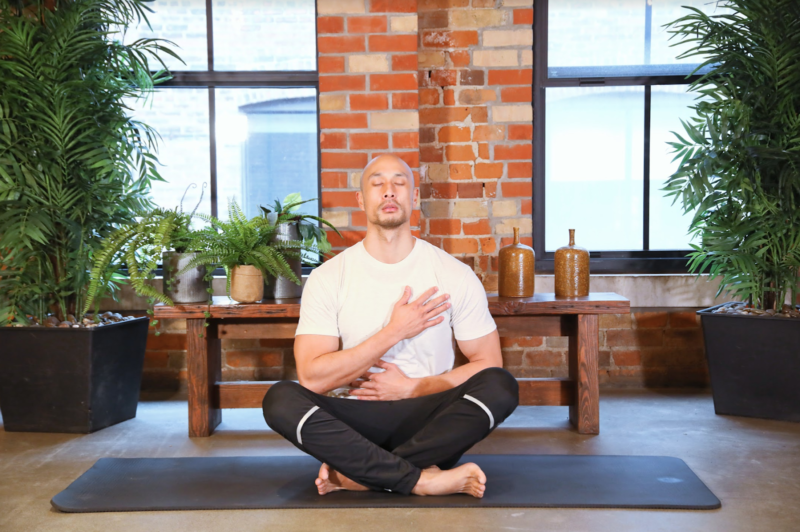The term breathwork broadly describes the mindfulness practice of conscious breathing: actively controlling the length and depth of your inhales and exhales to affect your emotional and physical state.
Our breathing changes all the time, whether we’re working, sleeping or exercising, and we may not realize the powerful effect it has on our body and mind. Consciously controlling our breath can help us take immediate control of our emotional state and let our bodies know that it’s safe to relax. By controlling the volume of oxygen we take in and the carbon dioxide we expel, we can adjust our own nervous system’s chemical makeup, which can have ripple effects throughout the body, including on our hormones and, ultimately, our metabolic processes.
Diaphragmatic Breathing
Although there are many different styles of breathwork with different reported benefits, the most researched category is diaphragmatic breathing.
Diaphragmatic breathing, sometimes called belly breathing, means taking long, slow breaths into the belly. It involves contracting the diaphragm, expanding the belly, and deepening inhalation and exhalation to decrease respiration frequency.
“Research shows that the physiological effects of an overactive nervous system and increased cortisol also have a negative effect on our metabolic fitness.”
The benefits of diaphragmatic breathing have long been recognized by ancient eastern religions and practices, such as Buddhism, martial arts, yoga, and tai chi. In these practices, deep, diaphragmatic breathing is thought to contribute to health and emotional balance.
Research is beginning to examine and acknowledge the value of diaphragmatic breathing exercises on our health. Several studies have linked slow breathing to reducing blood pressure, decreasing stress response, increasing heart rate variability (HRV – a sign of cardiovascular health and adaptability), and perhaps even improving cardiovascular health.
To better appreciate what’s happening in the body, let’s explore one of the interesting connections between breathing and metabolic fitness: the relationship between slow breathing and cortisol.
Stress and Cortisol
Cortisol is the body’s main stress hormone. It has many important physiological roles in the body, including helping to manage how the body uses carbohydrates, fats, and proteins, inflammatory processes, blood pressure regulation, blood sugar management, and following the circadian rhythm.
During acute stress, such as during exercise or when we’re scared, our bodies release a boost of cortisol to support our sympathetic nervous system or “fight or flight” instinct. This is a natural physiological process, and the cortisol dissipates relatively quickly.
However, in our current environment of constant modern stressors like traffic, text messages, or urgent emails, many of us experience continually elevated stress levels. This chronic stress can lead to emotional exhaustion, physical fatigue, and cognitive weariness—often known as burnout syndrome—which also features consistently high cortisol levels.
Cortisol’s Role in Metabolic Health
Intuitively, we know that the feeling of stress in our bodies doesn’t feel great. However, research shows that the physiological effects of an overactive nervous system and increased cortisol also have a negative effect on our metabolic fitness.
Metabolic syndrome is a group of health conditions that occur together, increasing the risk of heart disease, stroke, and Type 2 diabetes. Research shows that elevated cortisol is a common feature of many metabolic conditions, and its activity may contribute to the development of abdominal obesity with metabolic syndrome, Type 2 diabetes, atherosclerosis, hypertension, dementia, and depression.
Cortisol also has a direct effect on our glucose levels. As our body prepares to enter a state of fight or flight, cortisol increases energy availability in the short term by driving up our level of circulating glucose. To do this, it drives acute insulin resistance in our muscle and fat tissue so they take up less glucose, and it tells our liver to produce more glucose. That’s a useful response when the stressor is real and short-lived; today, it can just create chronically elevated blood sugar.
In addition to the direct metabolic effects of cortisol, it is common for stress to enhance cravings for high-sugar and high-fat foods. Finally, since cortisol affects blood vessel constriction, it can increase blood pressure during times of stress.
Reducing Cortisol with Breathing
Deep breathing exercises are becoming widely appreciated as one of the best ways to lower stress in the body and mind. A 2017 study found that salivary cortisol concentration decreased significantly after 20 sessions of diaphragmatic breathing. The authors concluded that deep breathing “[has the potential to] reduce negative subjective and physiological consequences of stress in healthy adults.”
Slow breathing practices, such as alternate nostril breathing, have also been found to down-regulate the sympathetic (or “fight or flight”) response. Regular practice of slow breathing for 30-minutes each morning and evening for three months had a statistically significant effect on reducing sympathetic nervous system activity.
Diaphragmatic breathing after exercise might also decrease the cortisol rise and oxidative stress associated with exercise. Initial evidence suggests that a recovery strategy including deep breathing techniques can help reduce cortisol levels and protect athletes from the adverse effects of free radicals.
Breathwork’s Effects on Glucose
If the ability of breathwork to lower cortisol is an indirect path to better glucose metabolism, some studies have looked directly at the effect of breathwork and its ability to affect the autonomic regulation of glucose control and insulin sensitivity, primarily in people with diabetes.
A study on regular practice of coherent breathing [more on that below] in people with Type 2 diabetes and ischemic heart disease saw participants increase their HRV and significantly lower their HbA1c after three months of consistent practice. Following other studies that show stress management can help diabetes control, the authors suggest that the breathwork decreased the activity of the sympathetic system, which helped improve glucose levels.
Another research team found that three months of breathwork (in a pattern similar to Buteyko [below]) reduced oxidative stress in people with Type 2 diabetes, as well as better trends in fasting glucose and HbA1c compared to people who did not do breathwork.
A study in healthy college-aged participants looked at the short-term effects of a couple of minutes of relaxed breathing (extending the length of your exhale) on glucose processing. Researchers had the students repeat the breathwork every 10 minutes for 30 minutes before drinking a 75g glucose load and for 90 minutes after. It found that the breathwork seemed to blunt the glucose peak, pushing it to 60 minutes instead of 30 in the control group and lowering it slightly.
Try It Yourself: Simple Breathing Exercises
Here are some different breathwork models similar to the ones mentioned in the research above. Although the exact methods differ, each exercise encourages deep, diaphragmatic breathing.
Coherent breathing
Coherent breathing (also called resonant breathing) is a slow breathing pattern of roughly six breaths per minute. The idea is that by slowing down our breathing, we force our autonomic system (which includes heart rate, digestion, and other unconscious processes) to slow down as well. Studies suggest that this kind of breathing may change brain activity in a way that decreases stress and anxiety and generally makes us feel better.
To practice coherent breathing:
- Seated in a relaxed position with your feet flat on the floor, or laying down comfortably, slowly exhale all the way to the end of your breath.
- Inhale slowly through the nose for a count of six, all the way in until you’ve reached your full lung capacity.
- On another count of six, exhale through the nose all the way until your lungs are empty.
- Repeat for as long as is helpful, until you feel relaxed.
It can be helpful and relaxing to follow along to guidance during coherent breathing. To practice at home, follow this video.
Buteyko breathing
The Buteyko method is the most advanced type of breathwork listed here. It is named after Ukrainian doctor Konstantin Buteyko, who based his work on the idea that most people were actually over-breathing and that breathing exclusively through the nose was best for our health.
To practice the Buteyko method:
- Begin breathing through the nose.
- Start to slow down the breath, keeping the breath gentle and quiet, rather than taking deep inhalations to the top of your lung capacity.
- Continue slowing down the breath until you begin to feel a slight air shortage.
- Resist the urge to take deeper breaths; maintain these light breaths.
- Continue breathing like this for one minute, focusing attention on the breath.
Try this guided video to practice the Buteyko method at home.
Alternate nostril breathing
Alternate nostril is the practice of gently closing one nostril at a time while slowly inhaling and exhaling. In at least one study, alternate nostril breathing helped to down-regulate the “fight or flight” response.
To try alternate nostril breathing at home:
- Sitting comfortably, exhale all the way through the nostrils.
- Use the right thumb to close the right nostril and inhale through the left.
- At the top of the inhale, release the right nostril, close the left nostril with the left forefinger, and exhale through the right nostril.
- Inhale through the right nostril, then switch back to blocking the right nostril, exhaling through the left.
- Repeat this pattern for 5-10 minutes or until you feel a renewed sense of relaxation.
Practice guided alternate nostril breathing to music at home, here.
This article was produced in partnership with Inward Breathwork, the world’s first on-demand breathwork platform. The website features structured programs to reduce stress, improve sleep, boost performance, and improve mood. Breathwork makes mindfulness fun, creating a feeling of relaxation you can feel in a single session. To get started with breathwork at home, try the Inward Breathwork free, three-day breathwork mini-series delivered to your inbox.








